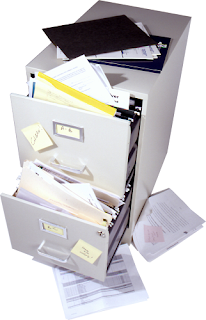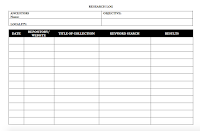What's Your Organizational Style?
My mother-in-law is a family history
nut. She is always looking for information on ancestors, finding old newspaper
clippings, and writing about the newest tidbit of family news. The work that
she has done will benefit our family history efforts for years to come; if we
can find what we are looking for. I recently asked her about an obituary for an
ancestor. I was rewarded with two cardboard boxes with the surname written on
them. Good to her word, I found the obituary about two-thirds of the way into
the second box.
We all have our own methods of
organizing the family history work that we have done. When we have a system that allows us to
quickly find our information, we make the most of the time we spend working on
extending our family trees. Having our work organized allows us to better share
and collaborate with other family history enthusiasts. An organized file of
information gives a professional feel that will inspire confidence in those
that you are working with. A final
reason to organize your files is that they will be passed on to others sometime
in the future. Just like a good research
log lets others know what has already been searched for, an organized file of
information will let future generations know what you have gathered. Nothing would be worse than having all your
work discarded because those who receive it feel that it isn’t worth searching
through.
The first decision you need to make
is how you want to organize your files.
Will you have a paper copy of every family tree and document? Maybe you want to keep all your information
on the computer. Keeping your file in both might give you a sense of security. Here are some tips that might help you get
your files into tip top shape. These can work for both paper and digital files:
- The best advice I could give is to be consistent. Find a system that you are comfortable with and stick with it. When you are consistent with your filing system you will always know how to find information you are looking for.
- Separate individuals into two time periods. Keep information on children with their birth families until the time that they marry. After they have married, create a new file with the new family name. Following this pattern with everyone in the tree makes it simpler to know where the information is.
- Label files in a way that you will know who they pertain to. Families often use the same names repeatedly. Make sure you can tell the difference by putting the name of the spouse or the birth and death years of the head of household along with the name. Doing this will help keep track of families with similar names.
- Make smaller files within the main file. Creating a separate file for land records, censuses, marriage records, and birth records will make finding the record you are searching for easier.
For
paper files:
- Any time you print a record or make changes to the family group sheet, file it immediately. Nothing is worse than looking at a stack of unfiled documents and not knowing where they go. Filing as soon as they are printed will keep your papers orderly.
We take pride in the family history work
that we do. When our records are organized
and easy to locate, we make the best use of our time. Those we give our work to
will appreciate the systematized histories they receive.


Comments
Post a Comment